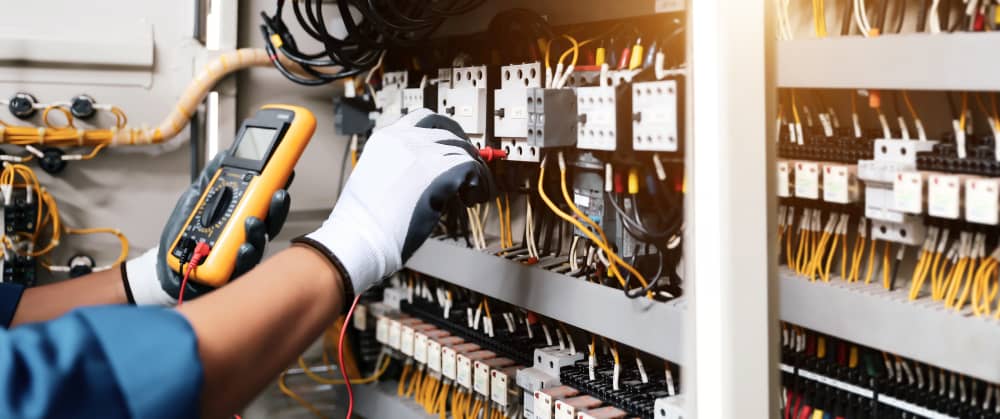Electricity powers the world we live in. From lighting our homes to running complex machinery, electricity is essential to modern life. Proper training and knowledge are crucial to working with electrical systems safely and effectively. Whether you’re an aspiring electrician or looking to do basic electrical repairs, understanding electrical fundamentals is the first step. This comprehensive guide will walk you through the basics of electrical training in a practical, step-by-step manner. We’ll cover critical topics like safety procedures, circuits, wiring, troubleshooting, etc. With the right foundation, you’ll gain skills to tackle electrical projects confidently. Let’s get started!

1. Safety First: Protecting Yourself When Working With Electricity
When undertaking any electrical work, safety must always be the top priority. Electricity is extremely hazardous and can lead to electrocution, shocks, burns, explosions, fires, and other serious harm if improperly handled. Therefore, before proceeding with any electrical project, it is imperative to implement a range of safety measures and precautions.
To begin with, you should de-energize and isolate any circuits you intend to work on. This involves locating the appropriate circuit breaker or fuse box and switching off the power supply completely. Additionally, unplug any devices also connected to the circuit. Make sure the circuit is dead using a non-contact voltage tester. Remember, never assume a circuit is safe based on simply turning off a switch – always test firsthand.
With the power safely cut off, take steps to prevent any chance of accidental re-energization. Padlock boxes and tag out switches clearly to avoid hazardous live circuits. You can use tags that say ‘DANGER – DO NOT OPERATE.’ Have another qualified person double-check that everything is fully de-energized before proceeding.
Next, wear the right protective gear when doing electrical tasks. Insulated gloves suitable for the expected voltage help guard against shocks. Safety goggles, face shields, and helmets prevent eye and head injuries. Insulated shoes with thick rubber soles add protection from the ground up. Flame-resistant clothing like fiberglass jackets and pants protect against burns from arcing faults. Make sure to inspect all safety equipment for any damage or wear before relying on them.
You should never work on electrical systems alone. Have at least one other person present to render assistance if required. They can switch off power, call emergency help, or provide first aid support in case of mishaps. Proper supervision prevents rushing or taking risky shortcuts that often lead to accidents.
Keep electrical work areas clear of any sources of moisture. Prevent bodily contact with any grounded surfaces as well. Any dampness dramatically reduces the body’s electrical resistance, making shocks far more likely. Only work in dry conditions to stay safe.
Additionally, use only properly insulated tools rated for the voltage levels encountered. Make sure the handles have no cracks or missing sections. Frequently inspect and test tools to verify their insulation integrity. Never use damaged or defective equipment.
Work in a careful, methodical manner without any haste when performing electrical tasks. Double-check connections before re-energizing circuits. Have work independently verified by a second electrician whenever possible. Rushing leads to mistakes and mishaps.
You can carry out electrical work securely by diligently applying essential precautions and safety practices. Always prioritize safety over speed or convenience when dealing with such a potentially hazardous force. For more information, check out this link: https://orion-technical.com/courses/basic-electricity-electrical-troubleshooting/ or other available resources.
2. Understanding Electrical Circuits
Electrical circuits provide controlled pathways for electric current to flow and do useful work. Grasping the fundamentals of how circuits operate is essential for both utilizing and installing electrical systems safely and effectively.
At its core, a circuit is a closed loop that allows electricity to flow from a source to a load and back again continuously. The power supply, wiring conductors, and electrical loads are the key components that enable this. The power source, such as a battery or generator, induces voltage to push electrons through the system. The conductors, usually copper wires, provide low resistance paths for current flow due to their free electrons. Finally, the loads convert electrical energy into light, heat, motion, or other forms based on their function.
For a circuit to work, it must form a complete, unbroken path from the source through the loads and back. Any gap or break in this loop interrupts the flow of electrons and stops current. Essentially, a circuit acts as a controlled riverbed, directing the electrical flow to where it is required.
While basic circuits have a single linear path, more complex configurations are possible. Multiple loads can be arranged in parallel branches, allowing current to divide while maintaining a constant voltage. Loads in series follow a single path, with voltage dividing across each one. Combinations of series and parallel connections can be designed to control voltage drops and current division for optimal performance.
Furthermore, circuits include devices like switches, relays, and fuses to add control capabilities and protection from faults. These alter the path dynamically or protect equipment in case of issues like short circuits or overloads. Properly incorporating such components expands functionality beyond simple energy transfer.
Studying circuits requires considering both the physical construction and also visualizing the invisible electron flow. Experimenting with simple circuits using batteries, wires, and loads helps build intuition. Measuring voltage and current at key points provides insights into circuit behavior and aids troubleshooting. A solid grasp of electrical circuits forms the basis for working with more advanced systems.
3. Series and Parallel Circuits
There are two fundamental ways in which multiple loads can be connected in a circuit:
Series Circuit:
- Loads are connected end-to-end in a single path.
- Current is the same at all points.
- Voltage divides across each load.
- If one load fails, the circuit is broken, and all loads lose power.
Parallel Circuit:
- Loads branch off from the source individually.
- Current divides between loads.
- Voltage is the same at all points.
- If one load fails, others remain powered.
Identifying series vs parallel connections is important for calculating load requirements and diagnosing faults. Here are a few tips:
- A series circuit has no branching. Loads all lie in a single path.
- A parallel circuit has multiple separate branches. Loads connect to individual paths.
- Use voltage readings to distinguish. Voltage drops in series but remains steady in parallel branches.
- Current splits between parallel paths. Current in series loops is equal throughout.
Practice constructing sample circuits to get comfortable with series and parallel configurations. Analyze the behavior using meters to measure voltage and current.
4. Working With Wires and Cables
Conducting electricity requires wires and cables. Various types are used depending on the application:
- Solid wire for permanent wiring inside walls and fixtures.
- Stranded flexible wire for connections to devices and equipment.
- Shielded power cables for noise resistance.
- High-temperature wire for motors and heating elements.
Other factors like gauge (thickness), number of strands, insulation type, and rating are also important for performance and safety.
When working with wires and cables:
- Use the right wire for the expected electrical load. Undersized wires can overheat.
- Ensure insulation is intact with no cracks or cuts. Damaged insulation can lead to shorts.
- Make clean wire terminations. Loose connections cause arcing and heat buildup.
- Use proper color coding. This helps identify hot, neutral ground wires easily.
- Secure wires neatly using ties or lacing. Prevent loose or dangling wires.
Taking care when selecting, handling, and terminating wires ensures safe and reliable electrical circuits.
5. Lighting Circuits and Controls
Lighting represents a major electrical load in any building. Designing lighting circuits correctly improves safety and efficiency. Here are some key guidelines when wiring lights:
- Use the recommended wire size based on the wattage of fixtures.
- Include a neutral return path equal in size to hot wires.
- Use independent circuits for high-wattage loads like large chandeliers.
- Install individual switches to control each room and area separately.
- Use three-way switching for staircases, hallways, and large spaces.
- Include dimmers appropriate to the light bulb type. Dimmers control brightness.
- Install occupancy and photo sensors to activate lights automatically.
- Use relay panels for centralized lighting control in large installations.
Planning lighting circuits carefully and providing flexibility through multi-point switching and dimming enables convenient, efficient lighting design.
6. Installing Residential Electrical Wiring

New home construction or remodeling provides an opportunity to upgrade electrical systems. Here is a simplified overview of installing new residential wiring:
- Plan circuit layout. Calculate the total load and required breaker size.
- Select a suitable wiring gauge and type. NEC (National Electrical Code) lists minimums.
- Mount the electrical panel/load center in a central location.
- Run circuit wires from panel to outlets and switches in each room.
- Pull wires through holes drilled in studs or joists. Use protective grommets.
- Open walls and drill through floor/ceiling joists to feed wiring between levels.
- Connect wires to devices like receptacles, switches, and light fixtures.
- Use metal boxes for housing devices. Secure boxes firmly.
- Label all wires clearly at both ends for easy identification.
- Conduct insulation resistance testing before energizing circuits.
- Connect circuits at the panel and install breakers.
- Attach cover plates and close up walls. Keep some access points.
- Test each circuit thoroughly under actual load before finishing.
A professional electrician can ensure electrical code compliance and safety during new wiring installation.
7. Fundamentals of Motor Control
Electric motors are essential to modern industrial activity. Correct motor control maximizes efficiency and longevity. Here are the basics:
- Include protective devices like overloads and short circuit protection. Prevent damage from faults.
- Use magnetic motor starters to switch motors on/off reliably and provide overload protection.
- Install properly rated and sized overload relays based on motor current.
- Provide control switches to start/stop motors safely. NEMA ratings must suit the location.
- Use legible schematic diagrams for motor control circuits. Follow standard symbols.
- Select controls to suit motor type. Common types: contactors, soft starters, VFDs.
- Provide proper enclosure ratings for dust/moisture protection. Use weatherproof types outdoors.
- Follow recommended motor wiring for voltage and connections. Use a wire gauge suitable for the load.
- Provide proper grounding and bonding. Use equipment grounding conductors (EGC).
- Use manual motor protectors like fused disconnects during maintenance. Prevents accidental restart.
- Label components. Warning signs show voltage rating and hazard level.
Applying basic motor control guidelines improves safety and enables trouble-free operation.
8. Electrical Troubleshooting Techniques
Systematic troubleshooting is essential when electrical equipment fails to operate correctly to determine the root cause and remedy the problem. There are several effective techniques electricians rely on to diagnose issues efficiently.
Firstly, begin troubleshooting by visually inspecting the overall system. Look for any noticeable damage like loose connections, burnt wiring, broken circuit boards, or faulty components. Visual clues can reveal obvious points of failure. Additionally, check that devices get the proper supply voltage using a multimeter. Power issues like low voltage can shut down equipment even if there are no internal faults.
Next, isolate the problem area as much as possible before testing. For example, turn off certain sections of a circuit to pinpoint faults in a particular location. This narrows the focus and speeds up troubleshooting. If a problem disappears when you remove a piece of equipment, that unit likely has an issue.
Analyzing the circuit paths methodically is also key. Check that there is proper continuity in wires and connections. Breaks or excessive resistance in the circuit prevent current flow. Use a multimeter to test conductivity at various points. Furthermore, inspect components like switches, relays, and motors for mechanical or electrical failures that disrupt the operation.
When fuses or breakers trip repeatedly, it signifies a short circuit somewhere. Carefully trace wire routings to check for pinched or bare spots that cause shorts. Motors and transformers that overheat can also develop internal shorts between windings. Such faults must be repaired before replacing fuses.
For suspected faulty devices, take resistance measurements and compare them to reference values. Significant deviations indicate worn-out contacts, open windings, or other deterioration. Consult wiring diagrams to methodically narrow down readings to pinpoint malfunctions.
As you test, carefully record all voltage, current, and resistance measurements. Compare readings between working and problematic areas to uncover inconsistencies that reveal flaws. Retest questionable parts under operating conditions to detect intermittent issues.
Finally, all identified faults must be corrected. This may involve replacing damaged wiring and burnt parts, resoldering loose joints, rebuilding motors, or other repairs. Rigorously retest the equipment afterward before returning it to service.
With patience and a structured, analytical strategy, even difficult electrical issues can be solved. Consistently applying proven troubleshooting techniques will lead you to the root of most electrical problems.
Conclusion
Working with electricity requires understanding fundamental concepts like safety, circuits, wiring, controls, troubleshooting, and more. This guide provided a broad overview of the basics involved in electrical training. With this foundation, you can confidently learn specialized skills for various applications of electrical systems. Continuous hands-on practice is vital to become proficient. Always exercise caution and follow safety protocols when dealing with electricity. The theoretical knowledge and practical experience will help you become skilled at electrical work while avoiding hazards. Keep learning and stay up-to-date on codes and best practices. Electricity is a powerful force that requires diligent study and respect. With the right attitude and effort, you can master this essential form of energy to power our lives conveniently and safely.




